|
Mass Transit Musings (2016-21)
Electric Bus Scam: More than two dozen electric Proterra buses first unveiled by the city of Philadelphia in 2016 are already out of operation. The entire fleet of Proterra buses was removed from the roads by SEPTA, the city's transit authority, in February 2020 due to both structural and logistical problems - the weight of the powerful battery was cracking the vehicles' chassis, and the battery life was insufficient for the city's 'easy' bus routes.
Philadelphia had placed the Proterra buses in areas where it thought they could succeed but quickly learned it was mistaken. Two pilot routes selected in South Philadelphia that were relatively short and flat compared with others in the city were too much for the electric buses. "Even those routes needed buses to pull around 100 miles each day, while the Proterras were averaging just 30 to 50 miles per charge," WHYY reporter Ryan Briggs wrote.
The city paid $24 million for the 25 new Proterra buses, subsidized in part by a $2.6 million federal grant.
Proterra had U.S. Energy Secretary Jennifer Granholm on its board of directors when Philadelphia pulled the buses off the streets last year. She is a staunch Democrat and is the former governor of Michigan.
Nevertheless, the company has been highlighted by the Biden administration as a business of the future. President Joe Biden visited the Proterra factory in April 2021 and pledged in his initial infrastructure package proposal to include federal money for the electric vehicle market. The company has since been touted by top officials including White House climate adviser Gina McCarthy, who in a public meeting asked Proterra's CEO how the federal government could spur demand for Proterra's (crappy) buses.
La Crosse, Wisconsin had ordered two buses from Proterra for $1.5 million in 2018. The buses have still not been delivered. Problems have been found in other cities that partnered with Proterra. Duluth, Minn., which, like Philadelphia, waited three years for its Proterra buses to be delivered, ultimately pulled its seven buses from service "because their braking systems were struggling on Duluth's hills, and a software problem was causing them to roll back when accelerating uphill from a standstill," according to the Duluth Monitor.
Randal O'Toole - the Antiplanner - noted that "Indianapolis, Albuquerque, and Duluth have all mothballed their electric buses or returned them to the manufacturers due to range and other problems. At close to a million dollars apiece, battery-powered buses cost almost exactly twice as much as Diesel buses. It so happens that the federal government will pay 80% of the cost of a Diesel bus but 90% of the cost of an electric bus, so for the transit agency, the cost of the two is identical."
And furthermore, a Proterra electric bus caught fire while charging in a southern California city that is now considering taking the electric buses off the road. Problems cited by the agency include not only the bus that caught fire in what's described as a "thermal event," but also buses that melt in the California heat and have transmission failures. Roland Cordero, the Foothill Transit agency's director of maintenance and vehicle technology, says the problems with the buses are exacerbated by Proterra's inability to help with repairs. Some of the Proterra buses have remained out of service for up to 275 days due to an inability to get replacement parts. The plastic interior panels, front wheel well cabinets, and driver bulkheads in the Proterra buses have deformed due to exposure to heat and sunlight. Foothill Transit serves the valleys surrounding Los Angeles.
As for that "thermal event," Don Surber wrote about this government-speak euphemism: "Ah, thermal events. I remember Jim Morrison singing, 'Light My Thermal Event'. And Smokey the Bear saying, "Only you can prevent forest thermal events." And of course, ready, aim, thermal event. The government never admits it is wrong until those who committed the wrong are dead."
John Hinderaker wrote that "companies like Proterra should be subject to massive consumer and securities fraud lawsuits, and maybe they will be. But political muscle goes a long way, and Proterra and its ilk are darlings of the Biden administration and the Democratic Party in general."
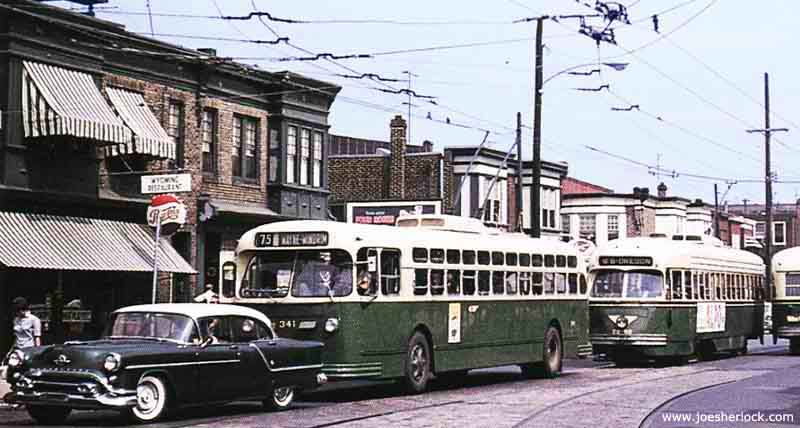
Philly's Route 75 line, shown in this 1957 photo, is still in operation.
The irony is that Philadelphia already has a fleet of electric buses - trolley buses (Philadelphians call them 'trackless trolleys') - which draw their power from overhead wires. Philly has had trackless trolleys in service since 1923 - almost 100 years ago. (posted 7/30/21, permalink)
The Little Transit System That Couldn't: Ambient temperatures exceeding 110 degrees caused Portland's Streetcar and Max light rail service to shut down. It seems that the overhead wires and insulators were not designed to handle the temperature expansion. It has been known for years that Portland's TriMet transit agency can't handle the heat: Whenever the temperature reaches 90 degrees, the Max trains slow down.
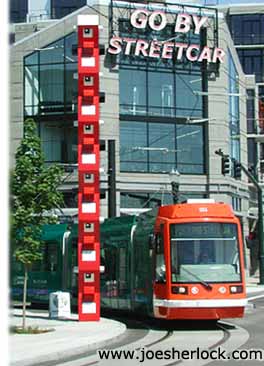
This is a case of incompetent design. The system also shuts down when it's cold, snowy or icy. Portland's transit agency has not figured out how to de-ice overhead wires or unfreeze icy switches - a problem solved by other transit systems over 100 years ago. Working on the Pennsylvania Railroad, my dad dealt with frozen switches all the time. His crew simply poured kerosene on them and started a fire. Ice melted; problem solved.
TriMet is the Goldilocks of public transit. It only works if it's not too hot or not to cold - everything must be "just right." Whoever designed the Max system should have his/her engineering license revoked and be sued for malpractice. The government officials who approved the system should be charged with malfeasance. (posted 7/1/21, permalink)
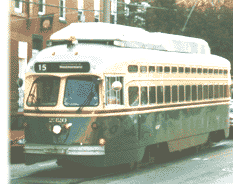 Slooooow Transit: Randal O'Toole wrote, "The first electric streetcars and the first internal-combustion engine automobiles were first developed just over 130 years ago. Initially, each went about 8 to 10 miles per hour. Today, people routinely drive automobiles at 70 to 80 miles per hour, and some supercars can go well over 200 miles per hour. Meanwhile, according to the American Public Transportation Association, the average speed of streetcars is a whopping 6.9 miles per hour." Slooooow Transit: Randal O'Toole wrote, "The first electric streetcars and the first internal-combustion engine automobiles were first developed just over 130 years ago. Initially, each went about 8 to 10 miles per hour. Today, people routinely drive automobiles at 70 to 80 miles per hour, and some supercars can go well over 200 miles per hour. Meanwhile, according to the American Public Transportation Association, the average speed of streetcars is a whopping 6.9 miles per hour."
Streetcars - aka trolley cars - have been obsolete since the 1920s. But cities are still building or expanding existing trolley lines because idiotic city planners think they're trendy. Streetcar lines cost taxpayers $25-50 million per mile to construct and carry relatively few passengers. Operational costs average seven times the fares charged.
Philadelphia has had trolley cars since the late 1890s and there are rails and infrastructure throughout the city (and some suburbs). Mr. O'Toole noted that Philadelphia "carried 45% of all streetcar riders in the country." But, despited in-place infrastructure and over a century of experience, fares collected cover only 39% of operating costs.
Streetcars may wow the tourists - just like they do in Europe - but cost taxpayers a bundle. That means you because, even if your city is trolleyless, most of these boondogles receive a lot of federal funding. (posted 9/10/20, permalink)
Travel Subsidies: Public transit is by far the most expensive and most heavily subsidized form of transportation in the United States. And many other countries, too. While transit fares are only a little more than the cost of driving, total transit costs average more than four times the total cost of driving.
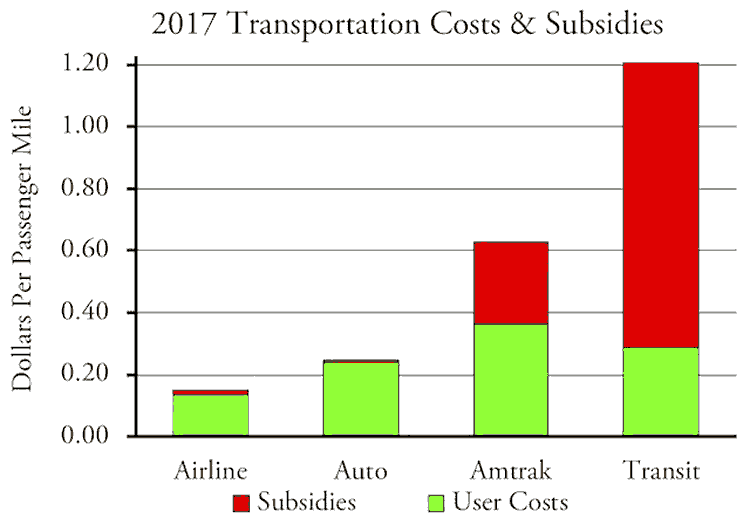
"User costs range from 14 cents to 36 cents per passenger mile and subsidies range from under a penny to nearly 92 cents per passenger mile, for total costs of 15 cents to $1.20 per passenger mile. Amtrak is the second-most expensive form of travel, costing more than four times the average cost of air travel. The Acela, the closest thing Amtrak has to high-speed rail, is even more expensive, costing well over a dollar a passenger mile once depreciation is counted." (posted 9/24/19, permalink)
Who Has Been Fired For This Colossal Waste Of Public Funds? The Seattle Department of Transportation ordered 10 new streetcars, at a cost of $52 million (over 5 million bucks each!), as it planned to link the two existing streetcar lines with a new line along First Avenue through downtown. But, the new streetcars are heavier and longer than the ones the city now operates, and it's unclear if they'll work on the current track or fit in the maintenance barn, according to Mayor Jenny Durkan's office.
Work on the new line has been halted because costs to operate the new system could be 50% higher than SDOT had publicly stated. "It appears the error will require either a change order for design of the streetcars or incur new costs for construction of new or retrofitted maintenance barns," said City Councilmember Lisa Herbold. The project would connect Chinatown-International District and Pioneer Square to the rest of our center city and South Lake Union, spreading homeless and criminals to nicer neighborhoods, - exactly as Portland, Oregon experienced twenty-plus years ago.
It wouldn't surprise me if Seattle eventually uses the trolley cars as homeless shelters. (posted 8/10/18, permalink)
Riding The Big Red Cars: The Red Arrow Trolley System served the suburbs west of Philadelphia in Delaware and Chester Counties and was operated by the Philadelphia Suburban Transportation Company.
Most of its trolleys were bigger and heavier than the ones in Philadelphia proper and many ran on their own right of way on the side of major roads.
When I was almost five years old ... (more >>>)
New Wine In Old Bottles: The latest over-hyped mass transit fad is the e-Bus, an electric bus. Major U.S. transit companies are unimpressed and keep buying diesels.
"Despite a surplus of cities seeking ways to reduce air pollution, electric buses haven't taken off in the United States as expected ... out of the more than 65,000 public buses currently on U.S. roads, only about 300 are electric ... they do require reliable charging infrastructure and a larger-than-average initial investment."
The first buses powered by electric motors appeared in ... (more >>>)
Grinding Away: An article in The Old Motor demonstrates that gas-electric hybrid vehicles are nothing new.
Photographed in May of 1940, this Rail Grinder was used to smooth imperfections in trolley car rails by the Philadelphia Transportation Co. The machine is moved by an electric car-truck with wheels and motor; the rubber covered steel wheels, powered by a gasoline engine, are used to move the machine out of the way of oncoming trolleys. Note the ... (more >>>)
Taxis & Trolleys: A 1939 Washington, D.C. photo posted by Ol' Remus at The Woodpile Report is captioned: "The intersection of 14th Street and Pennsylvania Avenue." Note the trio of '39 Plymouth taxicabs waiting for fares.
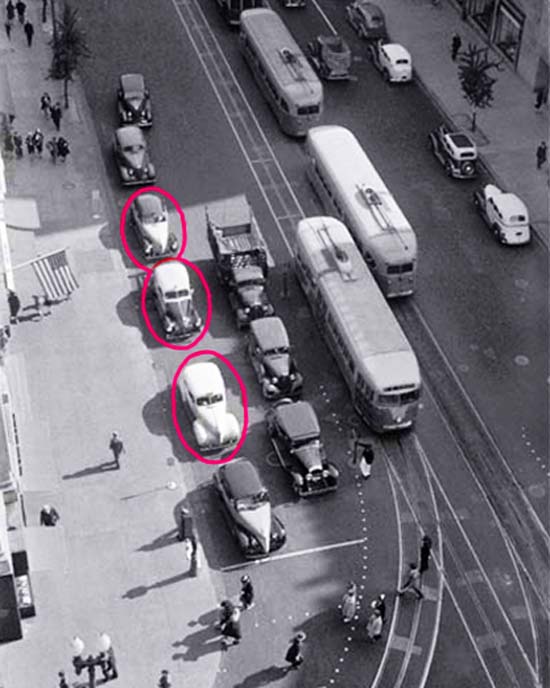
Three of Capital Transit Company's PCC streetcars are also operating along the street. CTC purchased its first streamlined PCC cars in 1937. No overhead trolley wires are visible because an 1893 Congressional law prohibited the use of overhead wiring of any kind in downtown Washington for aesthetic reasons.
Power for the streetcars was provided by a below-ground power accessed via a slot between the trolley rails. A pickup shoe (called a 'plow' by CTC employees) ran in a slot to access the underground conduit. In suburban portions of the CTC system, conventional overhead wires and trolley poles were used.
The last D.C. trolley lines closed in 1962. (posted 10/2/17, permalink)
Goldilocks Transit: Portland's TriMet Max light rail system can't handle heat. Whenever the temperature reaches 90 degrees, the trains slow down.
TriMet claims it's a "normal safety precaution." The light-rail system was built to run "in a mild climate with an average high of 55 degrees." When things get hot in the summer (Portland routinely experiences temperatures in the 90s every year), riders "should expect delays as TriMet reduces train speeds by 10 mph for all areas with a speed limit above 35 mph."
"TriMet is worried about copper overhead wires sagging. Since copper expands more than steel, the Max system incorporates pulleys with counterweights that tug on the wires to keep them tight. Sometimes, TriMet engineers say, things get so hot that the counterweights touch the ground and the wire starts to sag anyway." Who designed this thing anyway - the guy who did the specs for Galloping Gertie, the infamous bridge in Tacoma?
I have a book about the streamlined PCC trolley systems of yore. Titled 'PCC From Coast To Coast', it was published in 1983 and included trolley lines in such hot spots as Dallas, Fort Worth, El Paso, Birmingham, San Diego, Los Angeles and Mexico City. All of these transit systems easily handled hot weather conditions.
The book also had chapters on such chilly spots as Toronto, Montreal, Boston and Minneapolis. I mention these cities because TriMet's Max lines also shut down whenever there's a little ice. They haven't figured out how to keep overhead lines ice-free and deal with frozen switches. Working on the railroad, my dad dealt with frozen switches all the time. His crew simply poured kerosene on them and started a fire. Ice melted; problem solved.
TriMet is the Goldilocks of public transit. It only works if it's not too hot or not to cold - everything must be "just right." Whoever designed the Max system should have his/her engineering license revoked and be sued for malpractice. The government officials who approved the system should be charged with malfeasance. (posted 8/3/17, permalink)
In Philadelphia, The Liberty Bell Isn't The Only Thing That's Cracked: Service on Philly commuter trains has been interrupted due to serious defects found in Silverliner V cars, which are less than six years old. The cars were built by Hyundai, which had never built railcars for an American transit line before, and make up 30% of Philadelphia's commuter-rail fleet.
"Recently, a SEPTA worker noticed one of the cars was leaning to one side. A close look revealed a 10-inch crack in one of the car's wheel sets. Further inspection discovered similar cracks in 95% of the cars made by Hyundai. These have all been taken out of service, and the Southeast Pennsylvania Transportation Authority (SEPTA) has urged commuters to find another mode of travel for the foreseeable future."
|
|
While the sign shows the old Pennsylvania Railroad logo, all the commuter trains at center city's Suburban Station are now operated by the South Eastern Pennsylvania Transit Authority, a metro public transportation colossus. I was a frequent rider on the old PRR MP-54, owl-eyes commuter coaches - which ran out of Suburban Station - during my student years at Villanova University. Many of these old MP-54 coaches were built before 1920 and were still operational in 1980. Photo from our June 2011 Philadelphia visit; the train at right is a Silverliner IV.
|
On the Pennsylvania Railroad's Paoli Local, I used to ride the original Silverliner I cars, which were made by Budd Co. in the Philadelphia suburb of Red Lion, PA. Introduced in 1960, they worked just fine for many years.
"This isn't the first problem SEPTA has had with the cars and their manufacturer, Hyundai. Among other things, many of the cars were delivered late, the car exteriors had visibly "shoddy welds" and other evidence of poor workmanship, some of the motors refused to start up after being idle for 15 minutes or more, and some of the doors stopped working in cold weather.
Hyundai had seriously underbid its competition in order to get the order for the cars, and SEPTA awarded it the contract despite staff warnings about the company's inexperience. This led Kawasaki to sue, saying that Hyundai should have been disqualified because it didn't have a proven track record. Kawasaki won, the order was rebid - and Kawasaki didn't bid - so Hyundai got the order anyway." (posted 8/2/16, permalink)
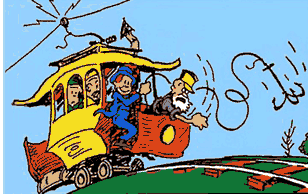 Backward Thinking: According to Randal O'Toole, if you're looking for "a magic formula for fixing congestion and other transportation problems, then Portland is the wrong place to look. The Portland area has already spent well over $4 billion on a light-rail system, yet as of 2014 light rail carried only 1% of the region's motorized passenger travel and no freight. Despite this, the region's leaders now want to spend $2 billion more on another 11-mile line." Backward Thinking: According to Randal O'Toole, if you're looking for "a magic formula for fixing congestion and other transportation problems, then Portland is the wrong place to look. The Portland area has already spent well over $4 billion on a light-rail system, yet as of 2014 light rail carried only 1% of the region's motorized passenger travel and no freight. Despite this, the region's leaders now want to spend $2 billion more on another 11-mile line."
Light rail, which when it was cheaper and privately owned used to be called trolley cars or interurbans. But light rail represents the past; trolley patronage peaked in the 1920s and has been on a downhill slope ever since the early 1950s. Self-driving cars represent the future (for those who aren't automotive enthusiasts). Self-drivers will render most mass transit obsolete.
But that's government - whether it's teaching methods, or transportation - looking backward, instead of forward. (posted 6/13/16, permalink)
Your Tax Dollars At Waste: Tri-Met, the transit agency for the Portland Oregon metro area, wants to build yet another light rail line, according to transportation expert Randal O'Toole.
Of course they do - most of the cost is reimbursed by federal funds, so it's like ... free money! Wheeeeee!
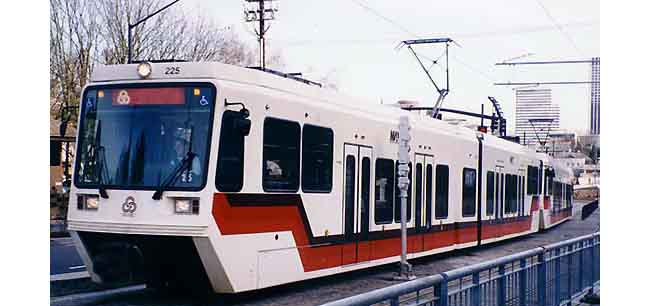
"A state auditor says TriMet, Portend's transit agency, is falling behind on light-rail maintenance. TriMet's general manager says that the agency's pension and health-care obligations are so great that it will have to cut all transit service by 70% by 2025 to meet those obligations. So naturally, it makes perfect sense to talk about spending $2 billion that the agency doesn't have on another low-capacity rail line." Sounds like today's DC Metro lines.
This one will run from Portland to its south suburb, Sherwood. This proposal is for an 11.5-mile line that will cost at least $2 billion, or $174 million per mile.
One commenter wrote, "Why are they doing this? The clear answer is to keep their jobs and benefits flowing. "… the agency's pension and health-care obligations are so great …"
By adding more projects and spending other people's money, they pay themselves more and increase their future pensions and benefits.
All the talk about caring about commuters and transit is just cover for scamming the funds." Amen. (posted 4/11/16, permalink)
The Universal Problem With Mass Transit: James Lileks wrote that "while driving around downtown I found myself not driving at all, because the lights prohibited forward motion when the light rail was in the neighborhood. One train was going west; the other, a few minutes later, was going east. The tracks pierce the intersection at an odd angle. No car moved for about five minutes.
Six light-rail cars, three per direction, trundled past. I counted 14 occupants."
When watching transit buses go by in Clark County Washington, I used to see full-size buses with only 6 or 7 passengers onboard. Then C-Tran got clever and tinted the windows to much darker shade than is legal for passenger vehicles. Now I can't see anything. (posted 2/3/16, permalink)
More mass transit musings can be found here.
Other Pages Of Interest
copyright 2016-21 - Joseph M. Sherlock - All applicable rights reserved
Disclaimer
The facts presented on this website are based on my best guesses and my substantially faulty geezer memory. The opinions expressed herein are strictly those of the author and are protected by the U.S. Constitution. Probably.
Spelling, punctuation and syntax errors are cheerfully repaired when I find them; grudgingly fixed when you do.
If I have slandered any brands of automobiles, either expressly or inadvertently, they're most likely crap cars and deserve it. Automobile manufacturers should be aware that they always have the option of trying to change my mind by providing me with vehicles to test drive.
If I have slandered any people or corporations, either expressly or inadvertently, they should buy me strong drinks (and an expensive meal) and try to prove to me that they're not the jerks I've portrayed them to be. If you're buying, I'm willing to listen.
Don't be shy - try a bribe. It might help.
|